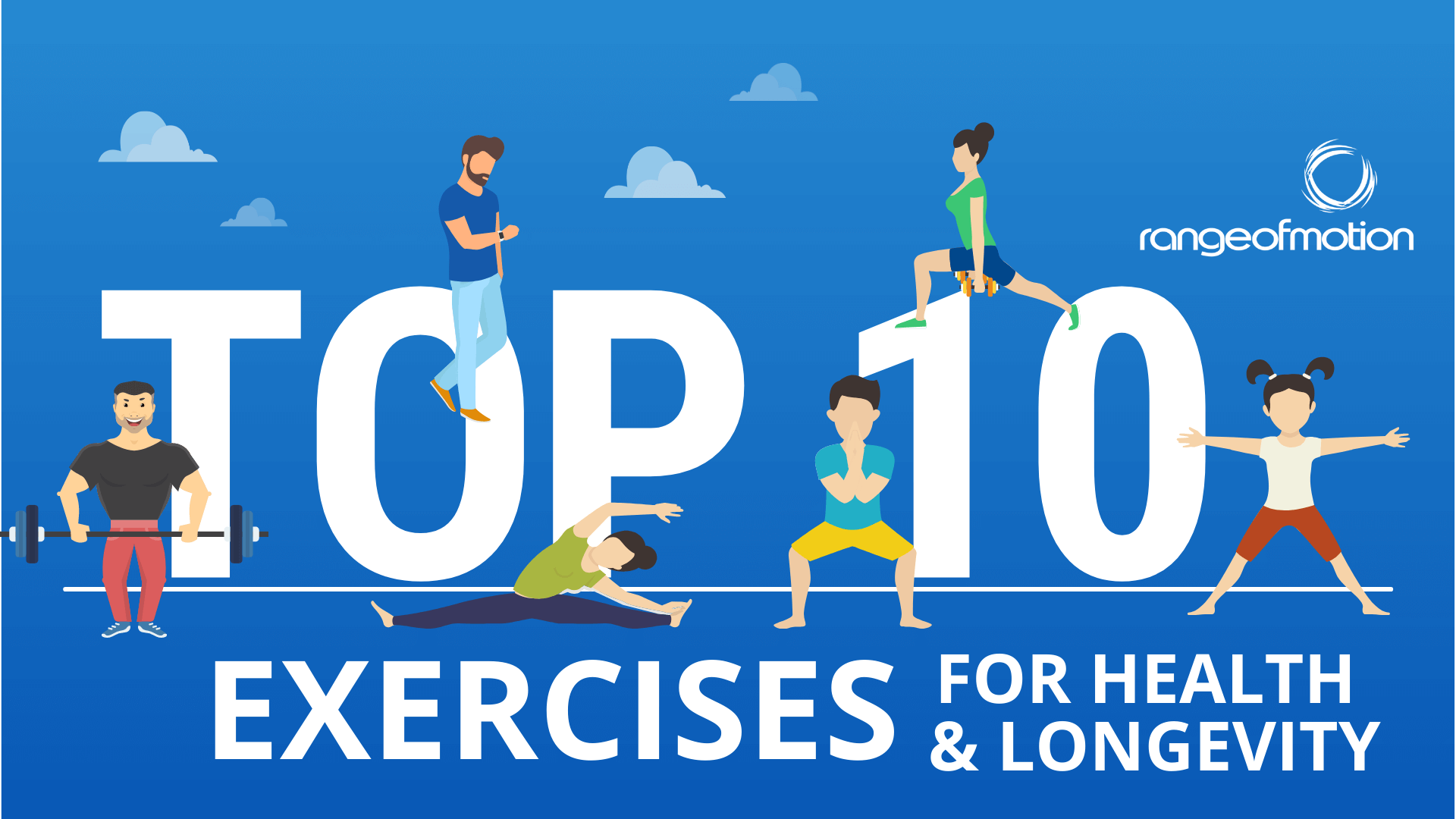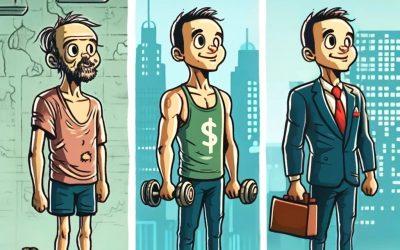Let’s count down our top ten exercises for health.
As with any top ten list, this is highly subjective, so let’s define the criteria.
We’re looking for exercises that build health above all else. Exercises that increase both lifespan and healthspan (functional longevity). Think of these movements as improving your quality of life, no matter the stage of life you’re in or the demands that life places on you.
We’re also looking for exercises that can ‘stand on their own’. That is, movements that can be done in isolation (not grouped with other exercises) and deliver wide reaching health benefits. Exercises that deliver a lot of ‘bang for their buck’.
Of course, questions in the health and fitness space almost always have answers starting with ‘it depends…’. And while this is true, and individual differences make general advice difficult, we’ve done our best and stand by the list.
So without any further ado, let’s start with number 10.
10. Walking
Grossly underrated! Walking is often disregarded by hardcore exercisers because it’s low intensity. While they have a point, we shouldn’t forget the mental, psychological and social benefits that come from a long walk.
For bonus points, walk with a friend, outside in nature, in the sun (within reason) and over uneven terrain.
9. Swimming
Spoiler alert, there are very few ‘bodyweight movements’ in our list. But swimming is definitely one of these. We’re moving our body through water so it improves our stamina relative to our bodyweight.
The cardiorespiratory benefits are enormous (swimmers are some of the most cardiovascularly fit people on Earth), and (as a full body movement) these benefits are universal.
There’s an escapism that comes from being in a ‘water world’, where phone notifications, bosses and needy family members can’t reach you!
There’s also a skill element, which is great because it allows you to develop mastery. With swimming you can mix different strokes, different intensities and different volumes, all of which offer different benefits.
8. Sit to stand
You may be surprised to see this in our ‘top ten’ list, but the absolute life-changing effect this can have on deconditioned or older populations earned it a place.
Basically, you sit on a low chair, then stand back up. Repeat. That’s it. There are few exercises that have as much carry-over into the ‘real world’.
The biggest benefits – it’s so simple to do, needs no coaching, and can be done by anyone (at varying heights of chair).
If you know someone who is deconditioned or elderly, doing these every day may change their life.
7. Trap bar deadlift
The ‘trap bar’ is a hexagonal shaped bar with parallel handles, We couldn’t have created a ‘top ten’ list without some form of deadlift and, in our opinion, the trap bar deadlift is most versatile.
This is the love-child of a conventional ‘straight bar’ deadlift and a squat.
It has almost as many posterior chain (back of the body) strength benefits as a deadlift, and almost as many anterior chain (front of the body) benefits as a squat.
For absolute strength, this is hard to beat (until we get to number two on our list!).
6. Power clean
Power is grossly underrated. So much emphasis is placed on strength, but power is the ability to not only lift something heavy, but to do it quickly. Speed-strength. As we age, it’s not a lack of strength that causes the downward spiral into deconditioning, it’s a lack of power.
The power clean builds enormous power and athleticism through the entire posterior chain of the body. Look at someone from behind. Everything you can see will benefit from the power clean.
The power clean also takes some learning, which has benefits to cognitive health.
5. Air bike
Surrounded by strength movements, this may seem to be an unusual entry into our list. The only pure ‘cardiovascular’ movement inside our top eight, we think the air bike deserves its place.
Firstly, there’s no part of your body that won’t benefit. The anterior and posterior chains of your lower body will be working, as will both the pushing and pulling muscles of your upper body. Nothing is safe!
This ‘full body effect’ means that not only will each part of your body benefit, but there’s a massive requirement to pump blood around the body to deliver oxygen and energy and remove carbon dioxide and waste. The high demands of this movement make it highly, highly effective.
All energy systems can be targeted. Very short efforts can build power. High intensity sprint work will have a massive systemic impact on the body. Longer continuous efforts are great for cardiorespiratory system development.
4. Loaded carries
There’s nothing more primal than picking up something heavy and carrying it – the heavier the better!
There are many different exercises we can classify as ‘loaded carries’, with many different implements.
You can carry things by your side, on your shoulder, hugged in to your chest, or in any other position you can imagine. And it doesn’t matter what you carry – in fact, the more awkward and unusual the object is, the better transfer it will have to your everyday life.
Loaded carries will make you strong and powerful. They’ll also build adaptability and functionality by challenging your body in ways it’s not used to.
3. Prowler push/pull
The prowler (or sled) has enormous upside, and very little downside.
We’re going to be a little cheeky here and (technically) include two movements at the number three ranking. The first is a prowler push, where you place your hands on upright vertical handles and push the prowler forwards. The second is a backwards drag, where you grip handles connected to the prowler by rope (or place a belt around your waist) and walk backwards.
Loading the prowler up with weights and fighting through a slow, grinding lap will make you strong. Dropping to moderate weight for high intensity repeated sprints will build an enormous anaerobic energy system. Reducing the weight for long unbroken efforts will build your aerobic capacity.
It’s also very hard to do these movements wrong, and the injury rates are really low. They’re also great for people with joint injuries – where they can work very hard without aggravation.
2. High bar back squat
The squat has long been called the ‘king of all exercises’, and while it’s been relegated to number two on our list, it was a close call!
The squat is absolutely unrivalled in its ability to build brute strength. The amount of muscle activation required throughout the entire body to stabilise the body and stand up a very deep, heavy squat is astronomical.
The muscular, nervous, skeletal and endocrine systems will all benefit.
1. Squat clean thruster
If there was only one exercise you’d do for the rest of your life, this would be our choice. This would be the exercise you’d take if you were stranded on a desert island!
So what is a squat clean thruster?
Well, it comes from the world of Olympic weightlifting, the world of some of the strongest and most powerful athletes on the planet. And if it works for them, it’ll work for us too.
You being by performing a squat clean. Then, as you stand up out of the squat clean, you continue exploding the bar upwards until it’s locked out overhead.
The shear number of benefits to this movement have meant we just couldn’t put anything else in the gold medal position on the podium. So let’s unpack some of these benefits.
Virtually every single major movement the body can perform is combined in a squat clean thruster. The posterior chain and upper body puling musculature is attacked during the pull from the ground to full extension. The anterior chain is responsible for standing up from the deep squat, where the pressing muscles of the upper body take over to complete the repetition.
*Incidentally, we choose a squat clean thruster over a squat clean and jerk because of the increased demand on this upper body pressing musculature.
From an energy expenditure or body composition point of view, big groups of muscles burn big bits of energy.
This movement builds both strength and power (power being the ability to move a heavy load quickly, and imperative for longevity). Not only is power needed, but the movement requires you to coordinate multiple movements in quick succession meaning your body becomes highly efficient at the skill of ‘moving things around’.
Hidden physical benefits include the beneficial effects on flexibility and mobility. We often think that training these elements of our health should happen before and after an exercise session, but there’s no reason they can’t be a part of it. The most common mobility deficiencies we see in the general population (around the ankle, hip, upper back and shoulder) are all tested and targeted.
Olympic weightlifting purists may not agree, but this movement can also be used a a cardiorespiratory conditioning tool. While Olympic weightlifting is traditionally completed in very short, heavy sets of 1-5 repetitions, I think we’re missing an opportunity if we don’t reduce the weight and increase the repetitions. There’s no reason you can’t do ‘cardio’ with a bar. Because of the extreme number of muscle groups and body parts involved in a squat clean thruster, the cardiorespiratory demand is very high. There isn’t an energy system in the body that cannot be trained with this movement.
The complexity of this movement may cause some people to omit it from a list like this – but we see this complexity as a blessing not a curse. You know how they recommend crosswords and sudoku to prevent cognitive decline? Well developing and practicing a new physical skill can have the same effect. The cognitive benefits of complex movement are highly undervalued. By balancing ability and difficulty this movement can even put you into a flow state.
We think our number one ranked exercise for health is a worthy recipient.
What did we miss? What surprised you? How would you change this list? Build your own top ten list (or steal ours) and make sure you’re incorporating the exercises in your own training. The will change your life.





